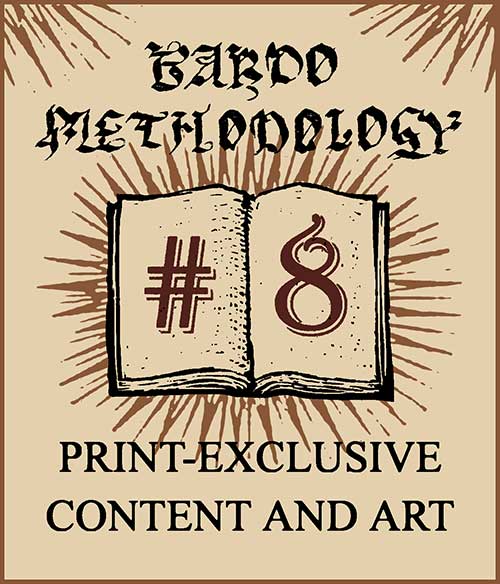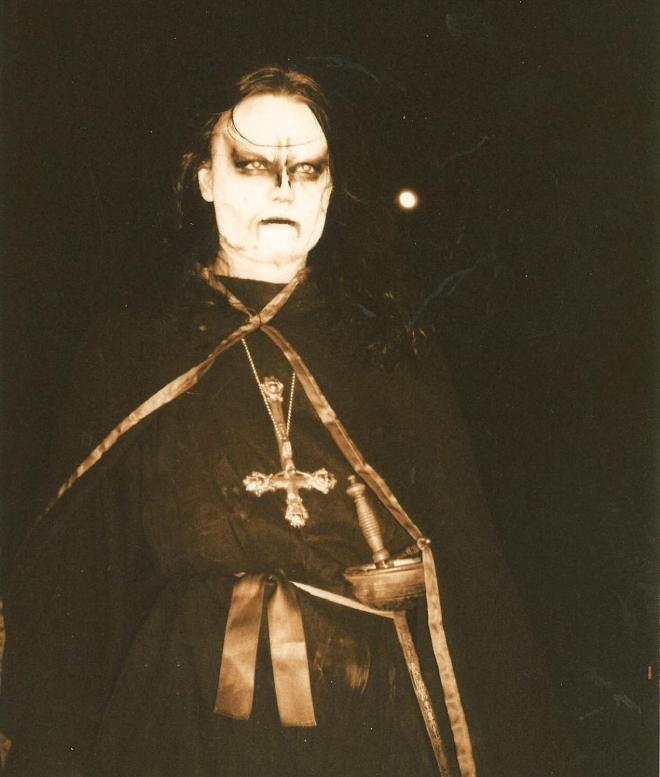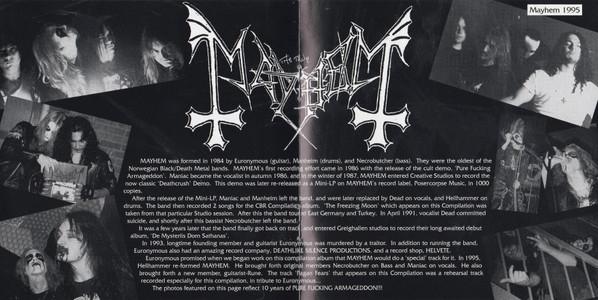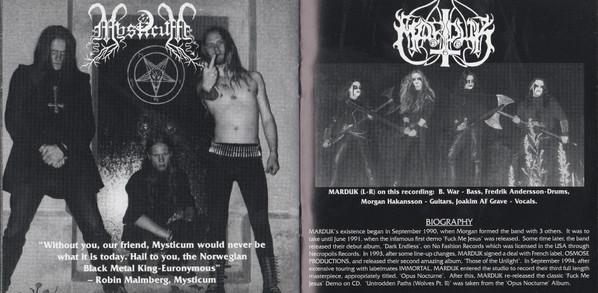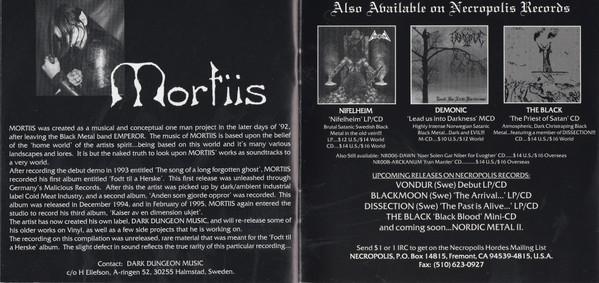Necropolis Records IV
2025-10-22
by Niklas Göransson
Through Nordic Metal: A Tribute to Euronymous, Necropolis sealed its covenant with the past, bearing the weight of a kingdom built on ruins. The compilation crowned its ascent – a testament forged from memories of blood and fire.
PAUL TYPHON: The story of Necropolis begins with the ARCHGOAT EP: NR001, pure anti-Christian warfare right from the start. Then came BEHERIT, absolute black metal legends. By the third release, you’ve got Jon from DISSECTION fronting THE BLACK – that alone was a statement of intent.
By 1995, Necropolis Records was an established presence in underground metal. THE BLACK, whose debut album, “The Priest of Satan”, became the label’s first official full-length, were joined by fellow Swedish acts like DAWN, NIFELHEIM, and ARCKANUM. Meanwhile, Paul had spent the past two years working on an ambitious compilation project.
PAUL: To me, “The Priest of Satan” is the ultimate Necropolis release, but “Nordic Metal…” ended up defining the label in most people’s eyes – probably because it brought together so many revered underground bands. I still see that compilation as the purest expression of black metal.
To trace its roots, we go back a few years. In the summer of 1991, around the time Paul began corresponding with Euronymous, the MAYHEM guitarist opened Helvete in Oslo. His shop became the heart of Norway’s emerging black metal movement, attracting devotees from all over the country. Later known as the ‘Black Circle’, this close-knit group cultivated an ethos of Satanism and extreme nihilism.
PAUL: My letters, calls, and exchanges with Euronymous revolved around his mission to spread black metal. The message – their particular brand of Satanism – mattered more to him than anything else. Shiva and I were completely aligned with that vision and its underlying philosophy.
By then, Euronymous was getting his own label, Deathlike Silence Productions, off the ground. The first proper release was MERCILESS’ “The Awakening” in 1990, followed by the BURZUM debut two years later.
PAUL: At one point, I suggested, ‘Why don’t we put together a sampler to introduce Scandinavian black metal to the US?’ In response, Euronymous proposed a compilation featuring D.S.P. bands like MAYHEM, BURZUM, ABRUPTUM, ENSLAVED, and MYSTICUM.
In 1992, Deathlike Silence act ABRUPTUM – a Swedish duo comprising IT of OPHTHALAMIA and MARDUK’s Morgan Håkansson – recorded “Obscuritatem Advoco Amplectère Me”, described by Euronymous as ‘the audial essence of pure black evil’.
ENSLAVED from Haugesund – a seaside town in southwestern Norway – had signed to D.S.P. and belonged to the same circle, as did Oslo’s industrial black metal band MYSTICUM.
PAUL: When first presenting my idea, I might’ve referred to the compilation as something like ‘The Black Circle’ or ‘Black Metal Mafia’ – terms often thrown around in correspondence at the time. But Euronymous said, ‘Let’s not call it that.’ He thought using those names would attract undue attention.
After a failed arson attempt at Bergen’s Storetveit Church in May 1992, the next month saw Fantoft Stave Church – a 12th-century landmark in the same region – burned to the ground. That blaze ignited a nationwide wave of fire-bombing, vandalism, and even murder associated with the Norwegian black metal scene.
Six months of anti-Christian attacks culminated over Christmas. On December 24, BURZUM’s Varg Vikernes and Jørn Inge Tunsberg of HADES torched Åsane Church in Bergen. The very next night, a Methodist church in Sarpsborg burned; Metalion of Slayer Mag was suspected and thoroughly investigated but never charged.
PAUL: Since both the press and police were already obsessing over the church burnings, he told us to destroy all of our written correspondence. Norwegian law enforcement was investigating the scene, monitoring people, and making arrests. Shiva followed Euronymous’ instructions, but I kept the last two letters.
Following his somewhat inexplicable decision to grant a sensationalist interview to Norwegian newspaper Bergens Tidende, Varg Vikernes was arrested in January 1993. In the ensuing media storm – complete with police raids, interrogations, and further arrests – Euronymous chose to close down Helvete.
In March 1993, after nearly six weeks in custody, Vikernes was released due to insufficient evidence. That same month, Deathlike Silence issued BURZUM’s “Aske”, its cover depicting the charred remains of Fantoft. It would later emerge that while recording the EP six months earlier, Vikernes and session bassist Samoth – also of EMPEROR – had burned Skjold Church, a fifteen-minute drive from the studio.
PAUL: The conversation gradually shifted towards launching Deathlike Silence America, as we spoke about earlier. Euronymous wrote: ‘I’m going to license the D.S.P. material to you; I’ll send everything in my next parcel.’ That would’ve been in August ‘93. When the package never came, I knew something was wrong.
Paul began asking around – and that’s how he learned that Varg Vikernes had killed Euronymous.
PAUL: Afterwards, word of the compilation spread. I was in touch with IT from ABRUPTUM; he and Morgan took on much of the responsibility for helping me finish the project. Hellhammer (MAYHEM) also supported it, so we had real backing to complete what Euronymous and I started.
The result – what we now know as “Nordic Metal: A Tribute to Euronymous” – would go on to take its place alongside “Vinnum Dei Satanas – The Wine of Satan” as one of the most important early black metal compilations.
PAUL: I coined the “Nordic Metal…” title after reflecting on how best to present the concept. The original goal was to gather the bands Euronymous personally respected, and we stayed true to that. Since the idea already existed in my head, I figured it would be relatively straightforward.
From speaking to others who’ve tried assembling compilations, I suspect this was a spectacular miscalculation.
PAUL: It turned into the hardest project I’ve ever managed – almost two years of contacting musicians, following up, chasing material, and clearing permissions. I personally dealt with every single band featured. Once things started moving, I took full ownership: ‘I’m seeing this through, no matter what.’
Coinciding with Paul’s twenty-first birthday, Necropolis Records released “Nordic Metal: A Tribute to Euronymous” in the summer of 1995. Many of the tracks were later reissued elsewhere – but at the time, it was an absolute treasure trove of past and present black metal history.
First out, we are treated to an unreleased ABRUPTUM piece: “De Profundis Mors Vas Consumet”.
PAUL: I needed an opener to set the tone – and what could possibly top ABRUPTUM? You don’t get many figures capable of making genuinely dangerous music, the kind true devotees crave. Those anguished howls, the stories about Morgan and IT cutting themselves… to me, that’s what black metal is supposed to be.
When recording “Obscuritatem Advoco Amplectère Me”, the duo improvised in near-total darkness, lit only by a single red lamp. Seeking authentic agony, both members sliced themselves up with box-cutters, screaming through the pain. IT even insisted on being pinned beneath a sofa to trigger claustrophobic panic.
More so than their sound, ABRUPTUM became hugely formative to Swedish black metal culture – not through theatrics or shock value, but the genuine drive to summon dread, discomfort, and spiritual unease.
PAUL: This music simply isn’t for everyone. Honestly, black metal should terrify you. Not horror movie scary – I’m talking about something so revolting, twisted, and disturbing you never want to face it again. My goal wasn’t for people to keep listening; I hoped they’d throw the CD out in fear.
A sort of bridge between ABRUPTUM’s magical demos – primal and lo-fi, but with actual songwriting – and the more atmosphere-driven debut, their opener is probably the compilation’s most iconic track. All the rumours about self-torture, many of them exaggerated, only amplified its impact.
PAUL: IT knew exactly what he was doing, and his vision of black metal heavily influenced “Nordic Metal…”. Morgan became deeply involved as well. He sent me many of the photos used in the booklet – including the cover – and provided the MAYHEM track from “Projections…”.
MAYHEM are represented by “Freezing Moon” and “Pagan Fears”. The former is a rare studio version featuring their late vocalist Dead – it originally appeared on the 1991 “Projections of a Stained Mind” compilation from Sweden’s Chickenbrain Records. “Pagan Fears” is a rehearsal recording by the post-Euronymous MAYHEM line-up: Hellhammer, Maniac, Blasphemer, and Necrobutcher.
PAUL: Hellhammer gave me his blessing to use both of them. We were in regular contact – I believe he was working as a prison guard at the time. Morgan reached out to Chickenbrain for approval; they seemed almost stunned that anyone would put together a tribute to Euronymous <laughs>. I also needed clearance for the two DISSECTION songs.
DISSECTION’s contributions, “Where Dead Angels Lie” – later appearing on “Storm of the Light’s Bane” – and a cover of TORMENTOR’s “Elisabeth Bathori”, came from “W.A.R. Compilation – Volume One”. The sampler in question featured almost entirely unreleased material, including two amazing KATATONIA tracks recorded between “Dance of December Souls” and “For Funerals to Come…”.
PAUL: Even though the DISSECTION songs had already been on the Wrong Again Records compilation, Jon Nödtveidt insisted they appear on “Nordic Metal…”, which I felt gave it a real sense of unity. The EMPEROR track with Hellhammer on drums was another interesting one.
In 1994, while EMPEROR were between drummers, Hellhammer helped them re-record “Moon over Kara-Shehr” from their 1992 demo, “Wrath of the Tyrant”.
PAUL: Samoth sent me that one. Euronymous wanted to sign EMPEROR and saw them as close allies, so their inclusion on “Nordic Metal…” was obvious. The same went for MYSTICUM, who were originally supposed to release their debut on Deathlike Silence.
Flyers promoting MYSTICUM’s upcoming album “Where the Raven Flies” were already circulating when Euronymous died. After his murder, D.S.P. distributor Voices of Wonder seized control of the label – a move that didn’t sit well with the band.
MYSTICUM’s “Nordic Metal…” contributions – “Kingdom Comes” and “In Your Grave” – were recorded for promotional use and later issued on a tape titled “Piss Off!!!”.
PAUL: The idea was to gather exclusive material – but that wasn’t always possible. Morgan didn’t have anything with MARDUK, so I asked Osmose; Hervé kindly allowed me to use a track from “Opus Nocturne”. Faust also proved instrumental, contributing both liner notes and an unreleased THORNS song.
At the time, Faust – former drummer of EMPEROR and THORNS, editor of Orcustus, and Helvete employee – was serving a fourteen-year prison sentence stemming from an eventful episode in August 1992. While visiting his hometown of Lillehammer, he fatally stabbed a thirty-seven-year-old man. Two days later, back in Oslo, Faust joined Varg Vikernes and Euronymous in setting fire to Holmenkollen Chapel.
PAUL: We’d been writing for a few years. In fact, I made those ‘In Support of Faust’ T-shirts, if you remember? Yeah, he gave me permission to sell them, but after the first batch of about thirty, he started catching heat. I mailed him one, and the prison staff saw the design <laughs>.
The photo – taken after the murder but before his arrest – showed Faust holding a knife.
PAUL: He told me it could land him in serious trouble, so I dropped the idea of printing more. Ironically, Snorre ended up on the compilation through THORNS – yet he was with Varg at Euronymous’ apartment. That inclusion happened because of Faust.
In May 1994, Snorre ‘Blackthorn’ Ruch, guitarist of THORNS, was sentenced to eight years in prison for helping Varg Vikernes gain entry to Euronymous’ apartment building.
I must say, having an accessory to Euronymous’ murder participating in a tribute to him is the perfect encapsulation of MAYHEM’s demented legacy – surpassed only by their debut album, “De Mysteriis Dom Sathanas”, featuring both killer and victim.
PAUL: Faust had a broader grasp of the scene by then, and I told him Euronymous wanted THORNS on the compilation. Oh, and he sent me the track on cassette; imagine me sitting in a mastering studio, piecing everything together with an engineer who had no idea what black metal even was.
OPHTHALAMIA, covering MAYHEM’s “Deathcrush”, had no direct link to Deathlike Silence beyond being the main project of ABRUPTUM’s IT.
PAUL: OPHTHALAMIA helped tie the Scandinavian scene together. With a compilation, you’re not only juggling logistics and rights, but also egos. The challenge isn’t just organisation – it’s opinions, of which IT had plenty <laughs>. He wanted the selection to reflect each band’s interpretation of Satanism and black metal philosophy.
ENSLAVED appears with “Loke”, taken from their recently released second album, “Frost” – courtesy once again of Osmose Productions.
The Voices of Wonder–run version of Deathlike Silence had issued ENSLAVED’s debut, “Vikingligr veldi”, in February 1994, but the band – like MYSTICUM and ABRUPTUM, who both signed to Full Moon Productions – broke contract soon thereafter.
PAUL: ENSLAVED is a great band, and I was friends with both Grutle and Ivar. Nonetheless, looking back, I’m not a fan of how far some Norwegians took the heritage themes. To me, black metal should remain rooted in Satanic and evil expression – that’s the inseparable essence.
Symphonic black metal act ARCTURUS featured a core of scene veterans – Hellhammer, Samoth, and main songwriter Sverd. The only outlier was their vocalist: Garm from ULVER, a young Oslo-based band who’d done a split EP with MYSTICUM the year prior.
ARCTURUS’ song was taken from their mini-CD “Constellation”, released in 1994 by Nocturnal Art Productions. Samoth had founded the label earlier that year, around the same time he received a sixteen-month prison sentence.
PAUL: I’d hoped to include “My Angel” – that old ARCTURUS seven-inch Shiva and I always loved – but Samoth sent us this newer track, “Raudt og svart”, instead. Still, it opened the door to emerging acts like ULVER and helped strengthen the Norwegian presence overall.
Closing the compilation is an outro by former EMPEROR bassist and dungeon synth pioneer Mortiis.
PAUL: Some people didn’t want him on there, but I pushed back – he’d always been part of the Norwegian black metal movement. Mortiis was close to Euronymous in the early days, so including his music felt essential. I also considered DARKTHRONE and IMMORTAL, but they stirred even more resistance.
log in to keep reading
The second half of this article is reserved for subscribers of the Bardo Methodology online archive. To keep reading, sign up or log in below.

